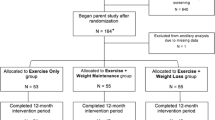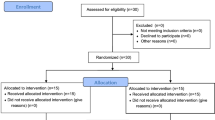Abstract
OBJECTIVE: The purpose of this study was to determine changes in adiponectin levels with moderate weight loss, weight loss plus aerobic exercise, or weight loss plus resistive exercise in overweight and obese, sedentary postmenopausal women.
DESIGN: Longitudinal, clinical intervention study of 6-month (3 × /week) program of either weight loss (WL, n=15), weight loss + aerobic exercise (WL+AEX, n=16), or weight loss + resistive exercise (WL+RT, n=9)
SUBJECTS: We studied 40 sedentary, overweight and obese (body mass index, BMI=32±1 kg/m2, X±s.e.m.) postmenopausal (57±1y) women.
MEASUREMENTS: Fat mass and fat-free mass (FFM) by dual-energy X-ray absorptiometry, plasma insulin, leptin, and adiponectin by radioimmunoassay.
RESULTS: Age, body weight, BMI, waist and hip circumferences, waist-to-hip ratio, VO2max, percent fat, total body fat mass, FFM, and fasting plasma glucose, insulin, leptin, and adiponectin concentrations were similar among WL, WL+AEX, and WL+RT groups before the interventions. In all women combined, body weight, BMI, and waist and hip circumferences decreased (P < 0.001). There was a significant absolute decrease in percent body fat from 47 to 44%, representing a 13% decrease in total fat mass and a −1.6% change in FFM. Fasting concentrations of plasma adiponectin did not change (40±16%, P=NS), whereas fasting plasma glucose, insulin, and leptin all decreased (P<0.001).
CONCLUSIONS: Plasma adiponectin levels do not change with a 6-month moderate weight reduction program even when accompanied by aerobic or resistive exercise training in overweight and obese postmenopausal women.
This is a preview of subscription content, access via your institution
Access options
Subscribe to this journal
Receive 12 print issues and online access
$259.00 per year
only $21.58 per issue
Buy this article
- Purchase on Springer Link
- Instant access to full article PDF
Prices may be subject to local taxes which are calculated during checkout

Similar content being viewed by others
References
Manson JE, Colditz GA, Stampfer MJ, Willett WG, Rosner B, Monson RR, Speizer FE, Hennekens CH . A prospective study of obesity and risk of coronary heart disease in women. N Engl J Med 1990; 322:882–889.
Folsom AR, Kaye SA, Sellers TA, Hong CP, Cerhan JR, Potter D, Prineas RJ . Body fat distribution and 5-year risk of death in older women. JAMA 1993; 269: 483–487.
Flegal KM, Carroll MD, Kuczmarski RJ, Johnson CL . Overweight and obesity in the United States: prevalence and trends, 1960–1994. Int J Obes Relat Metab Disord 1998; 22: 39–47.
Scherer PE, Williams S, Fogliano M, Baldini G, Lodish HF . A novel serum protein similar to Clq, produced exclusively in adipocytes. J Biol Chem 1995; 270: 26746–26749.
Maeda K, Okubo K, Shimomura I, Funahashi T, Matsuzawa Y, Matsubara K . cDNA cloning and expression of a novel adipose specific collagen-like factor, apM1 (adipose most abundant gene transcript 1). Biochem Biophys Res Commun 1996; 221: 286–289.
Nakano Y, Tobe T, Miura NC, Mazda T, Tomita M . Isolation and characterization of GBP28, a novel gelatin-binding protein purified from human plasma. J Biochem 1996; 120: 803–812.
Hu E, Liang P, Spiegelman BM . AdipoQ is a novel adipose-specific gene dysregulated in obesity. J Biol Chem 1995; 271: 10697–10703.
Arita Y, Kihara S, Ouchi N, Takahashi M, Maeda K, Miyagawa J, Hotta K, Shimomura I, Nakamura T, Miyaoka K, Kuriyama H, Nishida M, Yamashita S, Okubo K, Matsubara K, Muraguchi M, Ohmoto Y, Funahashi T, Matsuzawa Y . Paradoxical decrease of an adipose-specific protein, adiponectin, in obesity. Biochem Biophys Res Commun 1999; 257: 79–83.
Weyer C, Funahashi T, Tanaka S, Hotta K, Matsuzawa Y, Pratley RE, Tataranni PA . Hypoadiponectimia in obesity and type 2 diabetes: close association with insulin resistance and hyperinsulinemia. J Clin Endocrinol Metab 2001; 86: 1930–1935.
Hotta K, Funahashi T, Arita Y, Takahashi M, Matsuda M, Okamoto Y, Iwahashi H, Kuriyama H, Ouchi N, Maeda K, Nishida M, Kihara S, Sakai N, Nakajima T, Hasegawa K, Muraguchi M, Ohmoto Y, Nakamura T, Yamashita S, Hanafusa T, Matsuzawa Y . Plasma concentrations of a novel, adipose-specific protein, adiponectin, in type 2 diabetic patients. Artioscler Thromb Vasc Biol 2000; 20: 1595–1599.
Okamoto Y, Arita Y, Nishida M, Muraguchi M, Ouchi N, Takahashi M, Igura T, Inui Y, Kihara S, Nakamura T, Yamashita S, Miyagawa J, Funahashi T, Matsuzawa Y . An adipocyte-derived plasma protein, adiponectin, adheres to injured vascular walls. Horm Metab Res 2000; 32: 47–50.
Ouchi N, Kihara S, Arita Y, Mishida M, Matsuyama A, Okamoto Y, Ishigami M, Kuriyama H, Kishida K, Nishizawa H, Hotta K, Muraguchi M, Ohmoto Y, Yamashita S, Funahashi T, Matsuzawa Y . Adipocyte-derived plasma protein, adiponectin, suppresses lipid accumulation and class A scavenger receptor expression in human monocyte-derived macrophages. Circulation 2001; 103: 1057–1063.
Yang W, Lee W, Funahashi T, Tanaka S, Matsuzawa Y, Chao C, Chen C, Tai T, Chuang L . Weight reduction increases plasma levels of an adipose-derived anti-inflammatory protein, adiponectin. J Clin Endocrinol Metab 2001; 86: 3815–3819.
Hulver MW, Sheng D, Tanner CJ, Houmard JA, Kraus WE, Slentz CA, Sinha MK, Pories WJ, MacDonald KG, Dohm GL . Adiponectin is not altered with exercise training despite enhanced insulin action. Am J Physiol Endocrinol Metab 2002; 283: E861-E865.
American Diabetes Association and National Institute Diabetes Digestive and Kidney Disease. The prevention or delay of type 2 diabetes. Diabetes Care 2002; 25: 742–749.
American Heart Association Steering Committee. Dietary guidelines for healthy American adults. Circulation 1988; 77: 721–724.
Karvonen M, Kentala K, Mustala O . The effects of training on heart rate: a longitudinal study. Ann Med Exp Biol Fenniae 1957;35: 307–315.
Ryan AS, Pratley RE, Goldberg AP, Elahi D . Increased insulin sensitivity in post-menopausal women following resistive training and weight loss. J Gerontol 1996; 51A: M199–M205.
Harris JA, Benedict FG . A biometric study of basal metabolism in man. Carnegie Institute of Washington: Washington; 1919. p. 279.
Ryan AS, Elahi D . The effects of acute hyperglycemia and hyperinsulinemia on plasma leptin levels: its relationships with body fat, visceral adiposity, and age in women. J Clin Endocrinol Metab 1996; 81: 4433–4438.
Ryan AS, Berman DM, Nicklas BJ, Gingerich RL, Meneilly GS, Egan JM, Elahi D . Relationship between plasma adiponectin levels, body composition and glucose utilization across the adult age span. Diabetes 2002; 51(Suppl.): A405.
Treuth MS, Hunter GR, Kekes-Szabo T, Weinsier RL, Goran MI, Berland L . Reduction in intra-abdominal adipose tissue after strength training in older women. J Appl Physiol 1995; 78: 1425–1431.
Ballor DL, Keesey RE . A meta-analysis of the factors affecting exercise-induced changes in body mass, fat mass and fat-free mass in males and females. Int J Obes Relat Metab Disord 1991; 15: 717.
Matsubara M, Maruoka S, Katayose S . Inverse relationship between plasma adiponectin and leptin concentrations in normal-weight and obese women. Euro J Endocrinol 2002; 147: 173–180.
Fruebis J, Tsao TS, Javorschi S, Ebbets-Reed D, Erickson MR, Yen FT, Bihain BE, Lodish HF . Proteolytic cleavage product of 30-kDa adipocyte complement-related protein increases fatty acid oxidation in muscle and causes weight loss in mice. Proc Natl Acad Sci 2001; 98: 2005–2010.
Yamauchi T, Kamon J, Waki H, Terauchi Y, Kubota N, Hara K, Mori Y, Ide T, Murakami K, Tsuboyama-Kasaoka N, Exaki O, Akanuma Y, Gavrilova O, Vinson C, Reitman ML, Kagechika H, Shudo K, Yoda M, Nakano Y, Tobe K, Nagai R, Kimura S, Tomita M, Froguel P, Kadowaki T . The fat-derived hormone adiponectin reverses insulin resistance associated with both lipoatrophy and obesity. Nat Med 2001; 7: 941–946
Acknowledgements
Our appreciation is extended to the women who participated in this study. We thank Adeola Donsumu, Dana Jones, Agnes Kohler, Gail Chin, and Elizabeth Misiura for laboratory assistance. This study was supported by funds from NIH Grants K01-AG00747 (ASR), R29-A614066 (BJN), K01-AG00685 (DMB), the Department of Veterans Affairs, Geriatrics Research, Education, and Clinical Center at Baltimore.
Author information
Authors and Affiliations
Corresponding author
Rights and permissions
About this article
Cite this article
Ryan, A., Nicklas, B., Berman, D. et al. Adiponectin levels do not change with moderate dietary induced weight loss and exercise in obese postmenopausal women. Int J Obes 27, 1066–1071 (2003). https://doi.org/10.1038/sj.ijo.0802387
Received:
Revised:
Accepted:
Published:
Issue Date:
DOI: https://doi.org/10.1038/sj.ijo.0802387
Keywords
This article is cited by
-
Adiponectin receptor 1 could explain the sex differences in molecular basis of cognitive improvements induced by exercise training in type 2 diabetic rats
Scientific Reports (2023)
-
Effect of a weight loss program on serum adiponectin and insulin resistance among overweight and obese premenopausal females
Journal of the Egyptian Public Health Association (2020)
-
Impact of obesity on breast cancer recurrence and minimal residual disease
Breast Cancer Research (2019)
-
The effect of weight change over a 2-year period on inflammatory status in postmenopausal women
European Journal of Clinical Nutrition (2018)
-
Decreased lipogenesis-promoting factors in adipose tissue in postmenopausal women with overweight on a Paleolithic-type diet
European Journal of Nutrition (2018)



